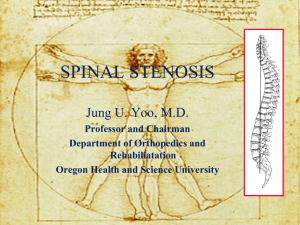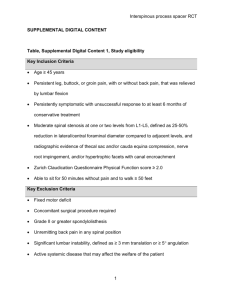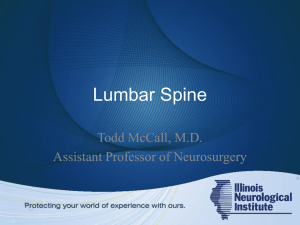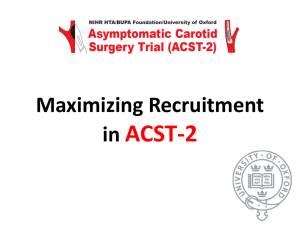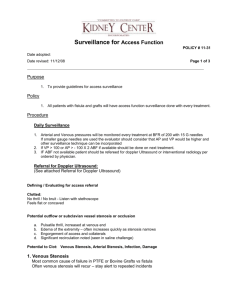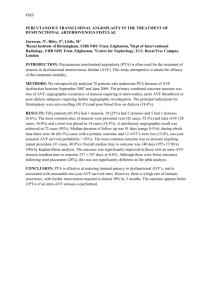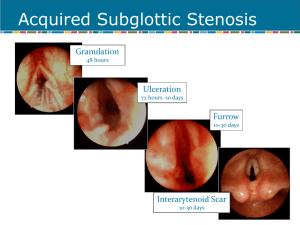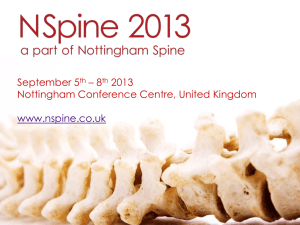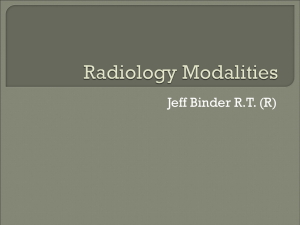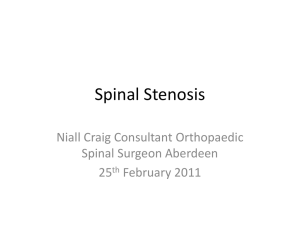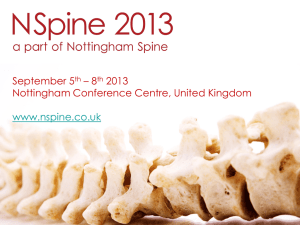09. Osteopathic Management of Patients with Spinal Stenosis
advertisement
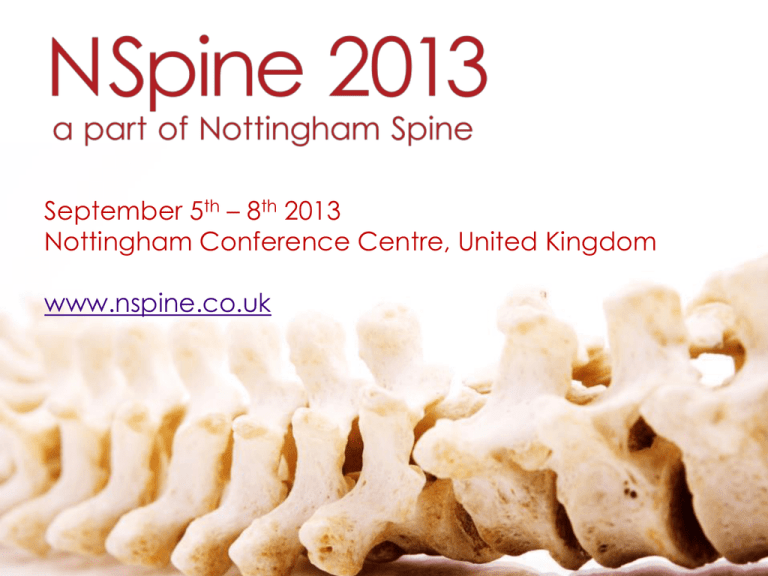
September 5th – 8th 2013 Nottingham Conference Centre, United Kingdom www.nspine.co.uk Spinal Stenosis Abnormal narrowing of the spinal canal, causing compression of the spinal cord and/or spinal nerve roots. Causes of Stenosis Aging factors that may cause spaces in the spine to narrow: Ligaments (ligamentum flavum) can thicken Bony spurs Intervertebral discs – bulge or herniate Facet joints break down Compression fractures – common in osteoporosis Cysts on facet joints • Arthritis • Hereditary • Instability, e.g. Spondylolisthesis • Trauma Classification 3 categories of spinal stenosis according to pathogenesis: Central Canal Stenosis Lateral Recess Stenosis Foraminal Stenosis Central Canal Stenosis Mainly caused by: hypertrophy of ligamentum flavum facet joint osteophyte formation degenerative spondylolisthesis May lead to compression of cauda equina. Lateral Recess Stenosis Compression between medial aspect of a hypertrophic superior articular facet & posterior aspect of the vertebral body and disc. Hypertrophy of ligamentum flavum &/or facet joint capsule, osteophyte or disc protrusion can exacerbate stenosis. The traversing nerve root is compressed in the lateral recess (e.g. L5 nerve root in the L5/S1 lateral recess). Foraminal Stenosis Rare. Mainly occurs in isthmic spondylolisthesis, where exiting nerve root is compressed in the distorted foramen (e.g. L5 nerve root in the L5/S1 lateral recess). Also occurs in far lateral disc herniation where the exiting nerve root is compressed in the foramen. Clinical Features Symptoms are insidious, generally presenting in the over 50’s. May be a long history of low back pain, but leg symptoms lead to presentation. Central canal stenosis - Bilateral leg symptoms which are vague & often described as heaviness, soreness or weakness. - Claudication – presents as numbness, weakness or discomfort in legs: may come on with walking or prolonged standing & is relieved by sitting or rest. Patients can walk further if leaning on a shopping trolley or uphill. - CES if severe. Lateral recess stenosis Unilateral radicular symptoms of leg pain with numbness, paraesthesia or burning in a dermatomal distribution. Natural History Course of spinal stenosis is chronic and benign. *Johnsson, Rosen & Uden followed up on 32 stenosis patients after a mean 49 months without any treatment. Of the 32 patients, 15% improved, 70% stayed the same, & only 15% became worse. *Johnsson KE, Rosen I, Uden A. The natural course of lumbar spinal stenosis. Clin Orthop. 1992; 279: 82-86. Management Conservative Analgesics NSAIDs Weight loss Physical therapy Surgical Decompression with or without fusion Osteopathic Considerations Patients that osteopathy can help are the ones that have no frank impingement of the spinal cord or nerves. Often unilateral foraminal encroachment is from long standing postural adaptations. Patients tend to present with reduced Lsp lordosis & a fixed flexed postural deformity - feel better when leaning forwards. ↓ Self-perpetuating cycle: adapted posture causes pain, then they flex to relieve the pain which causes worsening of the contractures. Shortened gait – shortened gluteii, etc. Treatment Strategy Introduce extension through Lsp, T/L & hips – release off the psoas, hip flexors and anterior muscle groups to relieve the pressure on the back. Use long levers. Work with soft tissue and rotational component of the spine to reduce the stress on spinal mechanics. Address segmental restrictions – often see many consecutive change over points: 1 flexed restricted segment, then 1 extended restricted segment, etc – often in Tsp. Improve global flexion and extension through Tsp/Lsp/Sacrum. Fine to HVT as long as there is no frank impingement. Tissues will revert to flexed/shortened state, therefore imperative to establish a good exercise regime to maintain lengthened muscles. Case Presentation Pt: M, 53yrs Presentation: Axial low back pain & bilateral LEX pain, >3yrs. Unable to walk more than 30-40yds before pain made him stop. PMH: Extensive physio, pain management, Gabapentin, Pregabalin, Caudal epidural & bilateral L5 root block (x2). Diagnosis: Degenerative L4/5 disc disease with foraminal stenosis. Surgical plan: L4/5 decompression. Osteopathic Evaluation: Restricted flexion left L5 & SIJ. Restricted extension L1-4. TTT given: Articulation of Lsp & L/S junction. Soft tissue stretching through hips and LEX. Encouraged extension through Lsp. Pre TTT ODI: 40% Post TTT ODI: 8% Able to walk >40 minutes and has returned to normal activity levels. Case Presentation Pt: F, 45yrs Presentation: Bilateral SI joint pain, with a history of axial low back and leg pain. PMH: L4/5 decompression & microdiscectomy. Assessment: SI joint injections gave complete but very short lived relief – diagnostic. Osteopathic Evaluation: Restricted flexion & extension in the right SI joint, left lower lumbar spine & right T/L junction. TTT given: Articulation, soft tissue work and manipulation to improve spinal mechanics. Pre TTT ODI: 42% Post TTT ODI: 16% Case Presentation Pt: M, 42yrs Presentation: Chronic neck & low back pain (4-5yrs). LBP radiating to right leg. PMH: Physio. Pain management (analgesia, Gabapentin). Diagnosis: Multi level disc degeneration in Csp & Lsp, with foraminal stenosis at C6/7 & L4/5. Osteopathic Evaluation: Flexion & extension restrictions at T9-SIJ & C1-T5 left. TTT given: Articulation of Csp, Tsp & Lsp. Mobilisation of hips and stretching of LEX soft tissues. Pre TTT ODI: Pre TTT NDI: 60% 66% Post TTT ODI: Post TT NDI: 8% 11% Patient resumed full employment.
